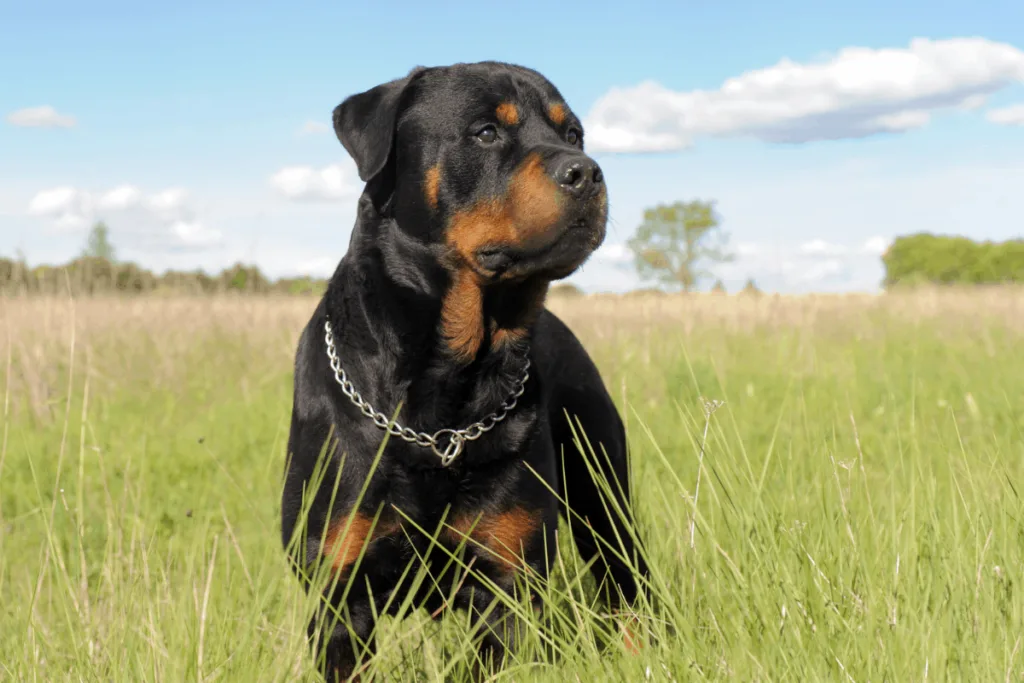
Rottweilers (aka Rotties) are descendants of Mastiffs – it’s no wonder then that this breed is powerfully built. Rotties are also charming and playful companions, beloved by canine enthusiasts worldwide.
If you’re the proud owner of a Rottweiler pup, you’re likely teeming with questions about your furry pal’s dietary needs. But, with the pet food market flooded with products – how do you go about making the right choice?
There’s a misconception that you can get away with feeding canines any readily available dry kibble brand and be done with it.
But, just like with humans, dogs have specific nutritional requirements that need to be met – if you want your pup to grow up healthy and strong.
Before you get too anxious – we’ve got you covered.
This Rottie-centric feeding guide will walk you through the various diet options available to you, along with the unique dietary needs of the Rottweiler breed.
All you need to do is stick with us to ensure your pet gets the tasty, wholesome, and age-specific diet it deserves.
Click Here to Jump to a Section
Rottweiler Dietary Needs
Not all doggos are created equal. Some canines are bred as working dogs and require a high-energy diet, while others have a slow metabolism that requires a low-caloric intake.
Similarly, selecting the proper diet for your Rottweiler depends mainly on several factors that can help guide your decision.
Feeling a little overwhelmed?
No problem – scroll down to discover the considerations to keep in mind when picking your Rottie’s diet.
The Age Factor
Age is always a factor when it comes to selecting pet products. It makes perfect sense too; after all, a puppy’s needs aren’t strictly comparable to those of an adult canine.
Rottweilers are a strong and muscular breed, which means your doggo’s nutritional needs will change correspondingly to its life stages.
All puppies tend to sleep a lot because that’s how their bodies conserve the energy required to do all the growing they need to do.
However, Rottie pups also go through an intense growth spurt between 5 to 7 months of age.
During this time, your puppy will require a high-quality diet that’s rich in protein to keep up with optimal muscle development.
Additionally, pups also need an adequate calcium-to-phosphorus ratio in their diets to ensure healthy bones and avoid joint and bone malformations.
When your canine enters adulthood, its metabolism and dietary needs change to accommodate its energy levels.
That’s why keeping your pet’s age in mind when opting for Rottie-specific food is essential.
The Size Factor
As per the American Kennel Club (AKC) breed standard, a Rottweiler can measure anywhere between 22 to 27 inches and can weigh around 77 to 132 pounds – depending on the gender.
While these specifications put Rotties in the medium-to-large dog breed category, you need to remember that each dog has its own quirks.
Your pet may not follow the breed’s growth chart exactly, which means you’ll have to account for its diet accordingly.
For instance, if your Rottweiler is beginning to look a little chunky, you may have to refer to your vet to adjust its diet to tackle the unhealthy weight gain.
One of the best ways to avoid health problems like obesity in canines is to opt for high-quality dog food designed to keep your pet feeling full longer without adverse effects on its health.
The Health Factor
No one likes to think about their pet suffering from some illness. But, the truth is – a wholesome diet can help keep your Rottie safe from a handful of disorders.
Rottweilers have a sturdy, muscular frame – which tends to put their joints and pressure points at risk.
They’re susceptible to conditions like hip dysplasia, elbow dysplasia, cruciate ligament rupture, etc.
All, if not most, of these issues, can be exacerbated by your pet being overweight.
What that means is that apart from supplemental aids like orthopedic dog beds and a regular exercise regime – you need to take special care of your Rottweiler’s diet.
A proper dietary plan makes sure your Rottie gets all the nutrients it needs without facing any adverse side-effects like weight gain.
Another health consideration when it comes to deep-chested canines like Rottweilers is bloat.
While researchers are unsure about the exact cause behind this life-threatening situation, a low-quality diet, along with too much food and extra carbs, can be contributing factors.
The Activity Factor
Rottweilers are classified as medium-to-high energy canines. That means there’s no way of being definitively sure about how your Rottie pup may turn out – it all depends on your pet’s individual system.
However, whether or not your Rottie is super-active will have an impact on its nutritional needs. I
f your pet has a high energy level and requires more exercise to work it off – it’s likely your pup’s going to have a more significant appetite than its not-so-active counterparts.
Besides that, you should also be careful about feeding your high-energy canine a diet that’s high in fats instead of proteins because it can lead to lethargy, apart from weight gain.
General Guidelines For Feeding Rottweilers
Pet experts recommend you observe your doggo when it comes to feeding – not its food bowl. That stands true for powerful canines like Rotties too.
This means pet parents should keep their Rottweiler’s age, size, and health in mind regarding their diet plan.
It’s easy to refer to canine food charts as the last word for food measurement. But, here’s the thing – food charts should be dealt with as a guideline.
That’s because food charts don’t take your Rottie’s unique circumstances into account.
For example, if your Rottweiler is gaining weight even after you’re sticking to the food measurement specifications – you’re going to have to tweak things to keep your pet’s weight on the healthy side of the spectrum.
That might start with cutting down on the number of treats or leftover scraps you’ve been giving your Rottie.
However, if the weight gain persists even after those measures, you may have to reduce the quantity of food you’re feeding your canine. Although, remember to reduce the amount of food in increments and never all at once.
Conversely, if your Rottweiler is underweight according to his age, you can try and steadily increase the amount of food you feed it.
Once again, an increase in the quantity of food should not be extravagant, and generally, increments by 1/4 of a cup should suffice.
Any and all changes to your canine’s diet – be it the quantity or switching dog food brands – should be done gradually.
Also, it’s a good idea to discuss your Rottie’s diet with your vet to ensure its health isn’t compromised in any way.
Sometimes, a sudden increase or decrease in your pet’s appetite can signal the presence of parasites like roundworms – which is why keeping your veterinarian in the loop about your canine’s diet is wise.
Food Proportions for Rottweilers
Alrighty, now that we’ve gone over some of the general canine feeding guidelines – it only makes sense to break down what your Rottie’s feeding guide (according to weight) should look like.
The chart mentioned below lists out how much dog food your pet should consume per day between the age of 6 to 12 months. You can download the chart as a reference.
However, note that the following guide includes suggestions and shouldn’t be followed down to the letter – especially if you feel your Rottie isn’t reacting too well.
Also, note that the guide includes the total quantity of food to be fed per day and not per meal.
That means if the chart mentions three cups of dog food, the number should be divided into however many meals you plan on feeding your Rottie (generally three times per day).
Don’t forget to observe your Rottweiler as it feeds. Some canines have the habit of gobbling down their meal, and if your pet is the same, don’t fill its bowl in one go.
Instead, try and add a little more food each time the bowl is near emptying – that way, you can keep quite a few digestive problems at bay.
Finally, unless your Rottie is a working dog or leads a very active lifestyle, start with the lower average and increase the quantity steadily.
This is where watching your Rottie, and not its bowl, will come in handy.
Rottweiler Feeding Guide According To Age
The age, growth, and development of your Rottweiler will play a big role in its dietary plan.
That’s why the following sections are devoted to discussing a Rottie-centric feeding guide based on different life stages.
All you need to do is find the right stage for your Rottweiler to access the relevant information.
Once again, remember that your vet is an invaluable source of pet-specific information for your Rottie.
Always make sure to discuss any diet-related changes with your vet before implementing them.
Rottweiler Feeding Guide: Birth to Three Months
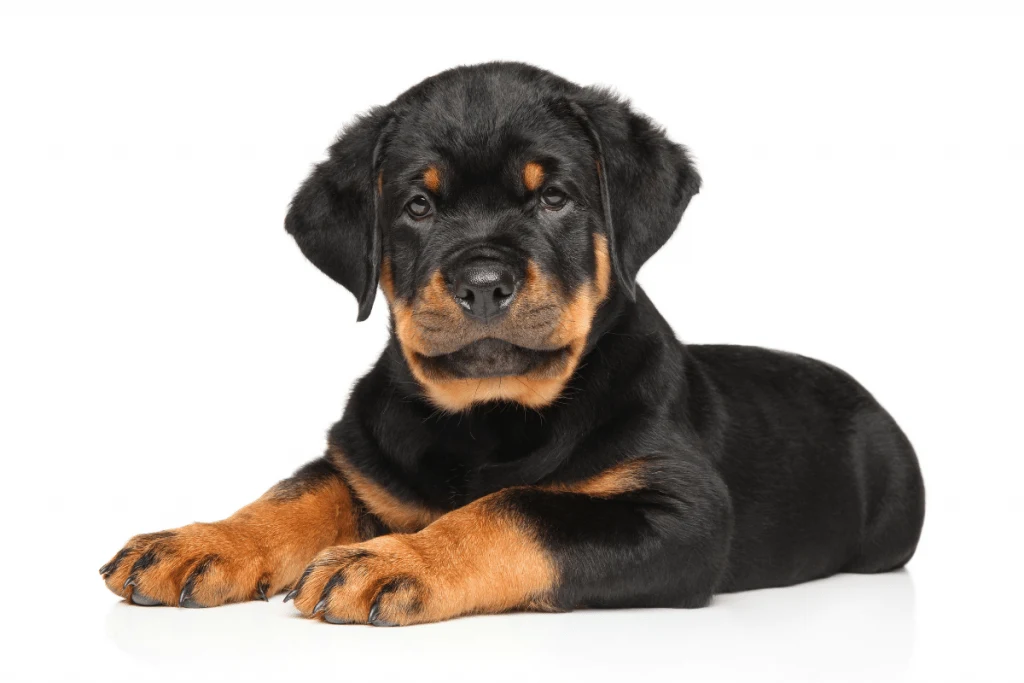
A responsible breeder will generally only agree to let a puppy part with its mother after 8 weeks of age.
That’s because the immunity and nutrition that a pup receives from a mother’s milk are essential to its well-being.
Once the Rottie pups are ready to be weaned, their diet shifts to include puppy mush.
If you’re wondering what puppy mush consists of – it’s basically (dry) dog kibble softened with water or puppy formula.
As your puppy continues to grow, the consistency of puppy mush will get drier until your pet can consume other types of puppy food.
When you bring your Rottie home, it’s wise to continue whatever type of puppy-safe food the breeder was feeding it.
Remember, abrupt changes to your canine’s diet can induce gastric distress and symptoms like diarrhea.
It’s also important to ensure that the food your puppy is used to eating is age-specific and not meant for older canines.
Puppy food is designed to cater to a growing canine’s unique nutritional needs to ensure overall dietary support.
After eight weeks of age, you can think about weaning your Rottie off from the breeder’s food and incrementally introduce them to their new diet.
You can do this by serving your pup at least 3 parts of the old diet, along with 1 part of the new food.
After three to four days, switch the ratio to 2:2 (equal parts of the previous diet with the new food brand).
Finally, change the mixture to three parts of the new puppy food and one part of the old after another few days have passed.
By a week and a half, you should have your Rottie puppy eating its new diet without any difficulties.
If the diet you’re feeding your furry pal is suitable, you’ll be able to see quite a difference in its weight from 8 weeks onwards.
For instance, Rottie pups at the 12-week mark can weigh anywhere between 33 to 37 lbs – depending on their gender.
If you find that your little pal is underweight, ask your vet about the possible reasons behind this.
You can also ask your veterinarian to recommend a diet that will help your furbaby catch up to its ideal weight bracket.
Another pro tip is to keep a close eye on your puppy as it’s chowing down.
Puppers are renowned for falling into their food dishes or tipping their bowls over.
Not to mention, they’re not wholly familiar with adequately chewing their food – which also presents a choking hazard.
You can feed a pup between 8 to 12 weeks of age around four to six times a day to ensure they eat their bellies full.
There’s generally no reason to cut down on your puppy’s food intake as they have a lot of growing to do.
Puppy-Friendly Recipe
If you end up getting your Rottie puppy before two months of age, knowing a puppy-friendly recipe (or a puppy mush recipe) may be essential to your little pal’s well-being.
However, this recipe calls for the use of puppy kibble, puppy formula, or water.
This is why it’s important to ask the breeder about the brand of puppy kibble or formula they were using for your pet.
Also, note that this puppy mush recipe makes use of equal parts and puppy kibble and puppy formula (or water).
You can increase or decrease the amount of kibble if you want to feed your pup a fresh meal whenever it’s hungry.
Ingredients:
1/4 cup puppy kibble
1/4 water (or puppy formula)
Directions:
- Place the kibble inside an adequately sized glass bowl.
- Heat the water or (puppy formula) in a pan. Next, pour the liquid into the bowl with the kibble.
- Grab a spoon and stir until all the kibble is well-coated. Cover the bowl with a dish or some foil and allow the kibble to soak up all the liquid.
- Once the kibble has absorbed all the water (or formula), mash with a fork until you achieve a pasty consistency. If your pupper is toothless, add in some more water to make it easier for the little guy or gal to lick the liquid mush. Additionally, don’t serve the mush until its room temperature.
Rottweiler Feeding Guide: Three Months to Six Months
When your Rottie pup crosses the 3 month (or 12-week) mark, you can ask your vet about reducing its feeding times (typically from four to three meals per day).
You’ll also want to look into getting your pup used to a timetable when it comes to mealtimes.
Not only will this set the tone for the future, but it’ll also help you with house training your puppy because you’ll accurately be able to guess its elimination times.
Rottweilers are prone to obesity, joint concerns, liver problems, bloat, etc., and that’s why it’s ideal to get your pup comfortable with the idea of a set amount of food per meal.
Your puppy may not like this new development initially, but you can steadily train it to recognize its free-feeding days are coming to an end.
Your veterinarian can provide you with invaluable information concerning your Rottie puppy’s diet based on its specifics, such as age, weight, and health, activity level, etc.
That’s why it’s always best to refer to your veterinarian about any diet changes you’re thinking about introducing.
Also, note that you shouldn’t disregard any recommendations from your vet for information gained from elsewhere (like the internet, for example).
Keeping that in mind, use the following feeding guide as a roadmap for what your Rottie’s meal times should look like.
From six months onwards, you can cut down your pup’s feeding time to three meals per day – if it’s growing the way it should and within the desired weight bracket (63 to 75 lbs).
You also have the option of downloading the size chart mentioned to use as a gauge.
It would help if you also kept a keen eye on how your pup’s body is developing.
If its round-belly days are behind it, and your puppy is beginning to attain a more streamlined body composition, that may signal your pet is ready for reduced feedings (with the proviso that your vet agrees it’s time for the change).
How Much Food Should You Give Your Rottweiler Puppy?
Certain canine breeds grow much faster compared to others, but all pups go through growth spurts.
For Rottweiler pups, the growth spurt generally starts at five months and continues till the seventh month.
Contrary to popular belief, a pup growing at a rapid pace shouldn’t be taken as an absolute indication of good health.
One of the dangers of your puppy growing too fast (outside the range of its expected growth spurt) is that it can face health concerns like joint problems and bone deformations.
With a breed like Rottweilers, who do tend to grow fast, it’s essential to know if your pup’s height and weight are progressing according to the breed’s growth rate.
For instance, if your puppy is overweight, you can slightly reduce the amount of food you’re feeding your Rottie so that its weight stabilizes.
That will also help keep extra pressure off your pup’s joints, pressure points, and the frame to ensure strong bone development.
A balanced diet plan will keep your pet’s weight in the preferred range and help regulate energy levels and blood sugar, ward off constant hunger and promote a stable growth rate.
If your six-month-old (male) Rottweiler clocks in at 73 lbs, that means its weight is almost ideal according to its age.
Using the feeding chart (meant for puppies aged 6 to 12 months) above for direction, you’ll notice that you can feed your 5 3/4 to 6 1/3 cups of food per day.
You have the option of starting at the higher average (which is 6 1/3 cups) until your pet reaches the weight of 75 lbs.
Once there, to maintain your pup’s weight, steadily reduce the quantity (not lower than 5 3/4 cups per day) to sustain your pup’s health.
So, you see, all canine charts – be they growth or food-related, are meant to be used as a guide by pet parents to ensure their puppy is well-looked after nutritionally.
It’s not an out-and-out schedule; it’s more of a balancing exercise.
Rottweiler Feeding Guide: Six Months to One Year
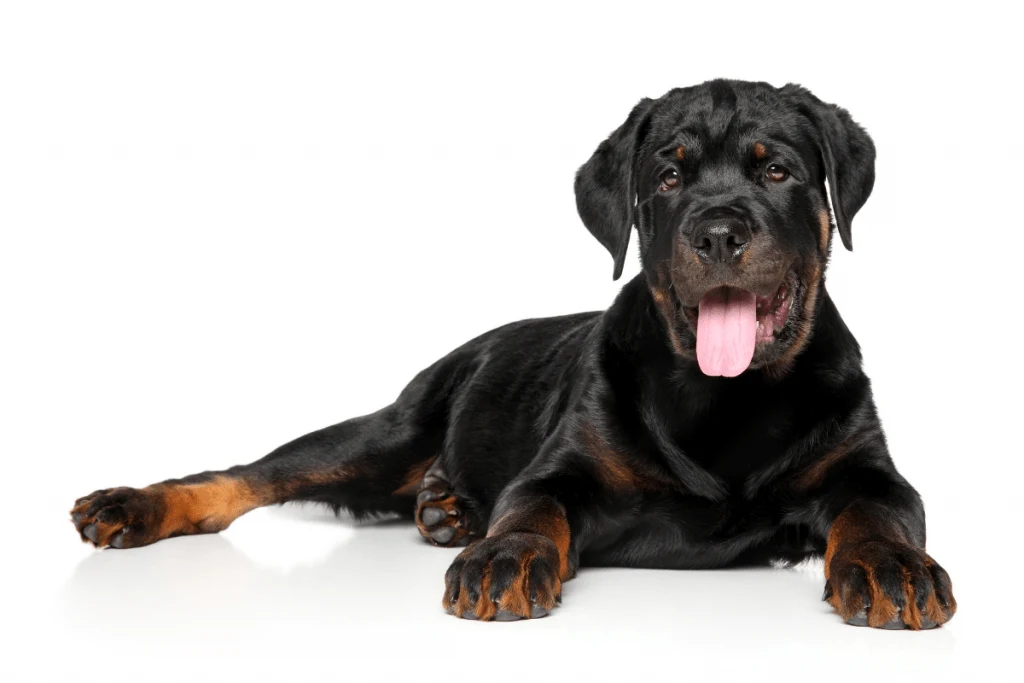
As you can see on the growth chart, Rottweiler males can go from 75 to 100 lbs from the six-month mark to one year. For females, the range is 63 to 93 lbs.
We know what you’re thinking – that’s a pretty steep increase.
Rotties experience a pretty intense growth spurt from 5 months onwards. That’s why their caloric intake remains high during this period.
Although, your goal is to achieve a steady rate of growth because a lot of weight gain all at once can affect your pup’s joints and bone health.
You can reduce your pet’s feeding times from three to two times a day if your vet approves of it.
Nonetheless, it’s wise to keep an eagle eye on your Rottie’s weight, activity level, and overall health to be able to gauge if the reduction in feeding times is suiting it.
You can also talk to your vet about when to switch your furball’s diet from puppy to adult dog food.
Generally, experts state that Rottweilers who’ve achieved 90 percent of their adult weight (90 to 100 lbs) can be switched to food formulated for adult canines.
But, as always, the introduction of a new diet needs to be gradual, so you can try and introduce the adult formula as a treat – to get your doggo familiarized with the flavor.
While sources on the internet state Rottie pups can be fed adult dog food at eight to nine months, the only course of action we suggest is listening to your vet’s advice.
Your vet will take into account your pup’s overall well-being before giving you a decisive answer.
So there’s no set limit for keeping your Rottie on puppy food, and you shouldn’t worry too much about it either if your pet is doing fine health-wise.
Rottweiler Feeding Guide: Adulthood
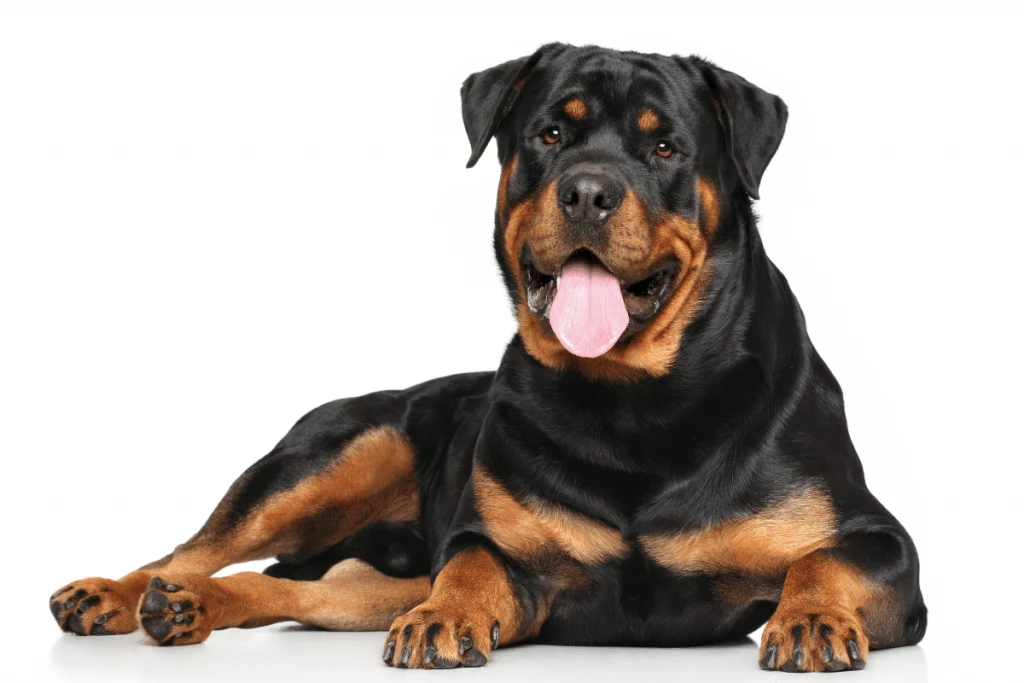
Between twelve months of age to a year and a half, your Rottweiler will achieve its full height.
This may make your pet look a little gangly and awkward, but Rotties don’t stop growing muscle and mass-wise until three years of age.
So, you don’t have to worry about things like malnutrition if your doggo looks a bit lanky during the age of one to three years.
Think of it as your Rottie’s teenage phase, which will end soon enough to give way to adulthood.
After your pet crosses the three-year phase, it’s safe to say your Rottie is an adult. Gone are the puppy fat and spindly legs to make room for a broad-chested, well-muscled canine.
By this time, your pet should have fully transitioned to a nutritionally well-balanced diet of adult food.
Adult canine food can cater to the needs of your fully grown canine, with essentials like protein, fats, carbohydrates, fiber, and of course, a unique ratio of calcium and phosphorus.
If you keep up with regular vet visits, you won’t have to face the consequences of feeding your adult canine puppy food, things like obesity, and other health concerns.
Typically, mature Rottweilers are fed twice a day. Breaking up the meal into smaller parts will not only help keep your pet feeling full for longer, but it will also be easier on your doggo’s digestive system.
Not to mention, there’s that added benefit of stable blood sugar levels – which leads to sustained energy levels and keeps your Rottie from feeling lethargic.
Another colossal health concern for large-sized canines is bloat (or Gastric Dilatation and Volvulus).
While scientists haven’t figured out the exact cause behind this life-threatening condition – two contributing factors are poor diet and eating too fast.
For that reason, we recommend you feed your Rottweiler high-quality dog food (with prime ingredients) in meals broken down throughout the day.
If you feel you won’t be able to implement a two-meals-a-day schedule, you can always invest in a food dispenser.
Coming to superior-quality dog food types – canine parents can find plenty of reputable commercial brands designed to sustain and nurture large to giant-sized doggos.
Ask your vet about Royal Canin’s Adult Dry Dog Food. This product comes highly recommended and includes chicken by-product meal, chicken fat, brown rice as the top three ingredients.
As the name suggests, the product is meant explicitly for Rottweilers over 18 months of age. It also offers nutrients such as EPA, DHA, and Taurine to promote cardiac function.
There’s also L-Carnitine and appropriate levels of protein to ensure muscle mass and bone health.
Rottweiler Feeding Guide: Golden Years
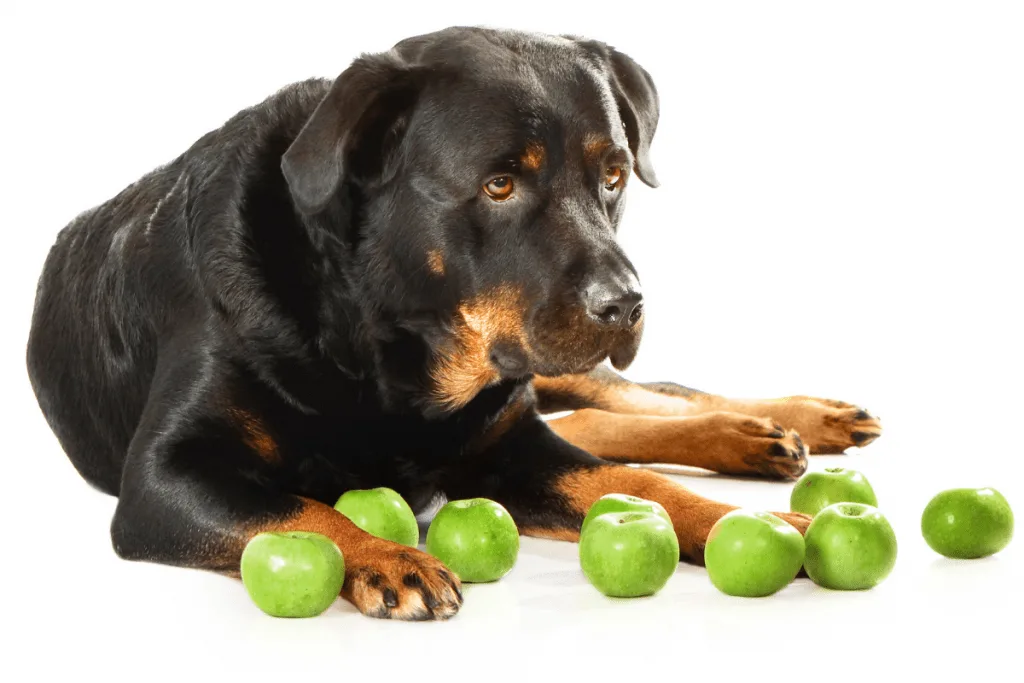
A Rottweiler’s lifespan ranges from ten to twelve years, which means your pet will reach the threshold of its senior years at 7.5 years of age.
Canines experience old age-related physiological changes, much like humans.
That means, as your doggo crosses seven and a half years, it can undergo a decline in its health if its diet doesn’t reflect its nutritional requirements.
Older canines may need a helping hand in matters such as low energy levels, digestion, orthopedic problems, etc.
Ask your vet when it would be a good time to adjust your Rottie’s diet to suit its age.
Senior Rottweilers require an easy-to-digest, nutritionally balanced diet.
This is because your pet’s system tends to slow down with age, and while seniors don’t need too many calories, they do require food that won’t overtax their digestive system.
A fiber-rich diet is also a good idea to ensure optimal nutrient absorption and a clock-work elimination schedule.
In short, a low-sodium, low-fat, and nutrient-specific diet can do wonders for maintaining your senior Rottweiler’s quality of life.
Also, try to incorporate healthy treats in your Rottie’s diet (low in fat, sugar, and salt) to make sure your pet has a diverse meal plan.
Try to switch to natural Rottie-friendly snacks high in antioxidants and other vitamins like blueberries, cranberries, carrots.
Antioxidants are especially useful when it comes to fighting off oxidative-stress related inflammation.
Avoid feeding your older canine table scraps or other human food items that may be high in salt or fat to ensure your pet’s health isn’t endangered in any way.
Rottweiler Nutritional Needs
We’ve discussed the Rottweiler feeding guide to some extent now. And, we’re sure you’ve noticed words like ‘nutritionally adequate’ or something along those lines repeated over and over.
It’s completely understandable if you’re wondering the heck that means precisely. Don’t worry – we’ve got you covered in this section.
You see, an animal’s diet (including humans) needs to be a mix of nutrients (compounds in food that are necessary for life).
When talking of Rottweilers – the nutrient blend needs to include proteins, fats, carbohydrates, vitamins, minerals, and water.
And because canines are obligate carnivores, the protein derived from meat sources works better for them.
But does that mean all meat-source proteins work for Rottweilers?
According to the author of the book ‘The Best Diet for a Rottweiler,’ William D. Cusick – Rottweilers tend to do better with protein from sources such as poultry, lamb, or dairy.
When you’re out browsing for dog food for your Rottie, choose a brand that lists chicken or lamb as the top protein quotient. Avoid products that include fish or beef protein.
On the other hand, Cusick states that carbs from wheat or brown rice are better than soy or corn because they’re easier to digest and don’t encourage unhealthy weight gain.
Natural fat can help maintain your Rottweiler’s energy drive and promote skin and coat health.
However, remember that canines require a minimum of 5% fat intake daily. Too much fat can lead to digestive concerns and obesity.
Vitamins and minerals are necessary for chemical reactions in the body that aid various biological processes.
A natural vitamin and mineral source always trumps a synthetic one.
Talk to your vet about how to look after your Rottweiler’s vitamin needs through natural sources like fruits or vegetables.
Additionally, unlike humans, dogs can synthesize Vitamin C in their livers – which means most of the time, your canine will not require a Vitamin C supplement.
In fact, Cusick warns that too much Vitamin C in a Rottweiler’s diet can lead to kidney and liver problems.
Finally, always ensure there’s a water bowl around for your Rottweiler to quench its thirst. It’s always best to change the water regularly to keep the supply as fresh as possible.
Raw Food Diet And Other Alternatives
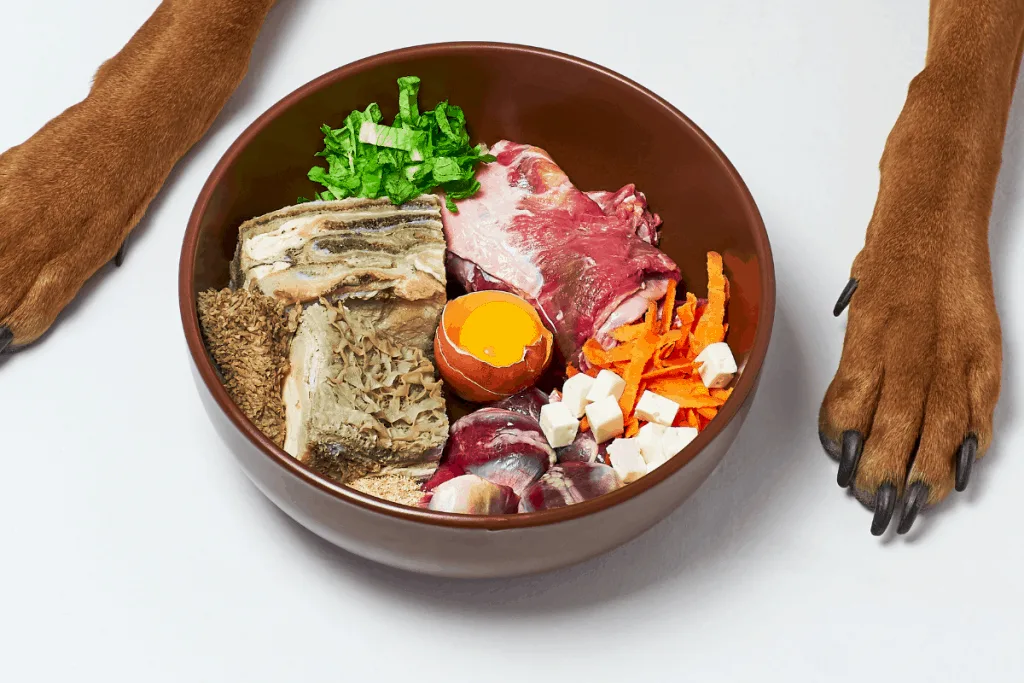
There are options like a raw food diet or home cooked meals for pet parents who’re interested in adopting an organic lifestyle for their Rottie.
However, before adopting any alternative diet for your doggo, it’s best to have a long and detailed conversation with your vet about what the process involves.
Not to mention, unless you’ve done serious research about a particular doggy diet fad, it’s best not to consider them the gospel.
It’s not like there aren’t less than ideal ingredients in certain commercial dog food brands – but the FDA regulates finished pet food products and the ingredients – which means companies have to adhere to specific standards.
Unfortunately, going it alone with an alternative dog food diet will require you to study your canine’s nutritional needs, metabolism, and life stages in detail (unless you’re a pet nutritionist).
That requires a lot of time and effort and isn’t something that should be attempted half-baked.
Rottweiler Supplements
As stated earlier, the Food and Drug Administration regulates pet food and its ingredients to ensure the products offer optimal nutritional levels for your pets.
Nonetheless, high-quality dog food with its premium ingredients is best for feeding your Rottie a well-balanced diet.
Technically, because all your canine’s nutrient requirements are met through its diet – there’s rarely an occasion that requires you to turn to supplements – be it vitamins, minerals, or any other kind.
It’s never safe to incorporate a supplement (even ones that are available over the counter) in your Rottie’s diet before checking it out with your vet first.
That’s because some supplements can do your Rottie more harm than good.
Besides that, never try and add a human supplement to your pet’s diet because even if they’re not harmful to humans, they’re designed for human consumption and may include substances that are harmful to your canine’s health.
Final Thoughts
We understand your Rottweiler’s health is priceless to you.
That’s why it’s wise to stick to top-end reputable dog food brands with straightforward ingredients and nutrition profiles.
This can ensure your pet gets the diet it deserves, and you’re not left in the dark about what you’re feeding your Rottie.
Not to mention, a healthy diet will not only save your Rottie from unnecessary health problems but may also help save your dollars upon dollars in savings from avoiding all those trips to the vet.
What more could you ask for?
